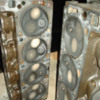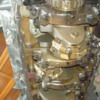OK another dumb rookie question. I located the 4 digit serial number below the left head which matches the car's body tag. This 1974 wreck that I have had early model parts on it so I'm curious to see what engine is in it. Where is the casting number that identifies the block/heads located? I read about casting numbers DOAE-XXX and such and also letter codes (H, Q, R etc.) Where are these found? I googled it and all of the sites that I found listed the codes but none showed it's location on the block.
Original Post



